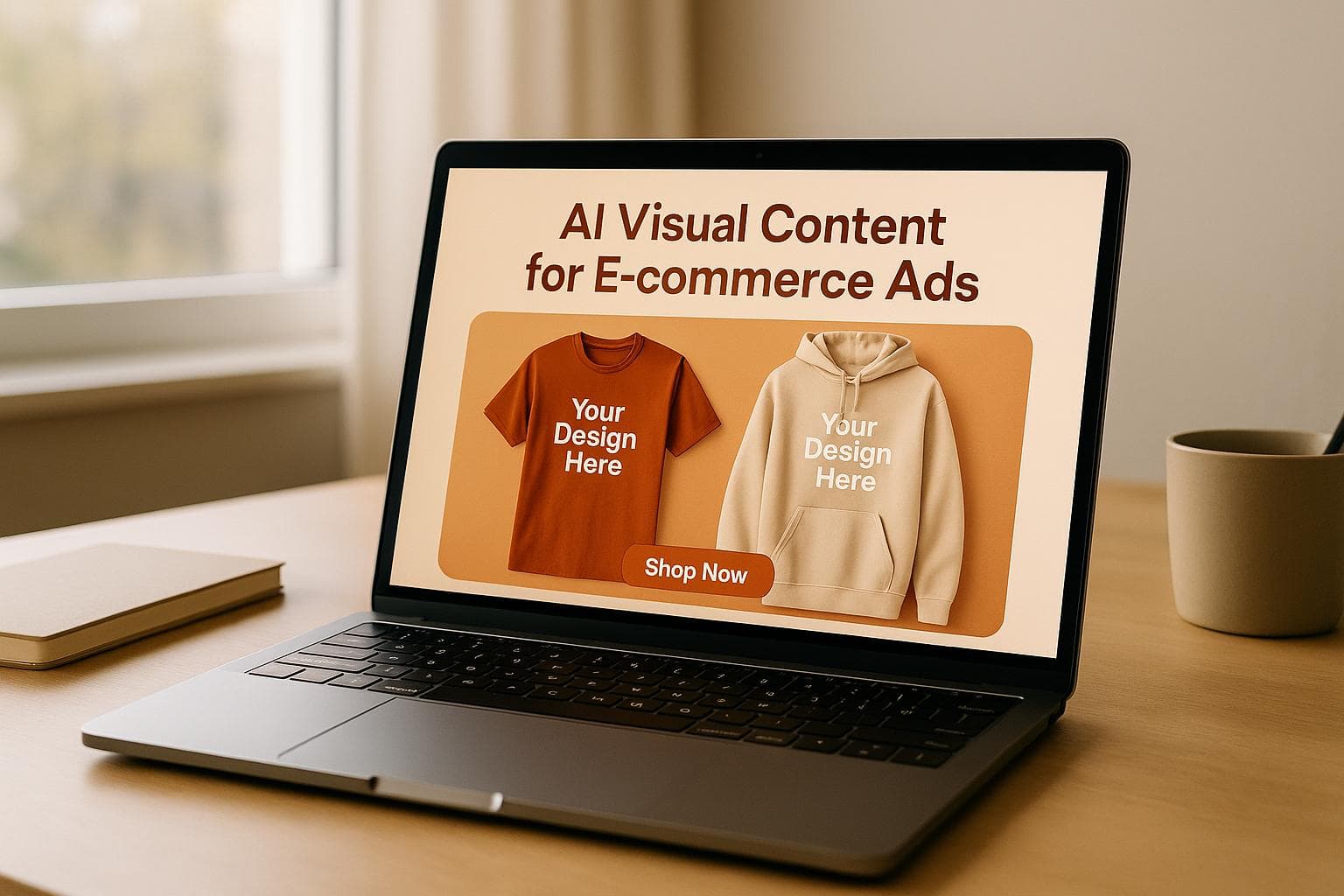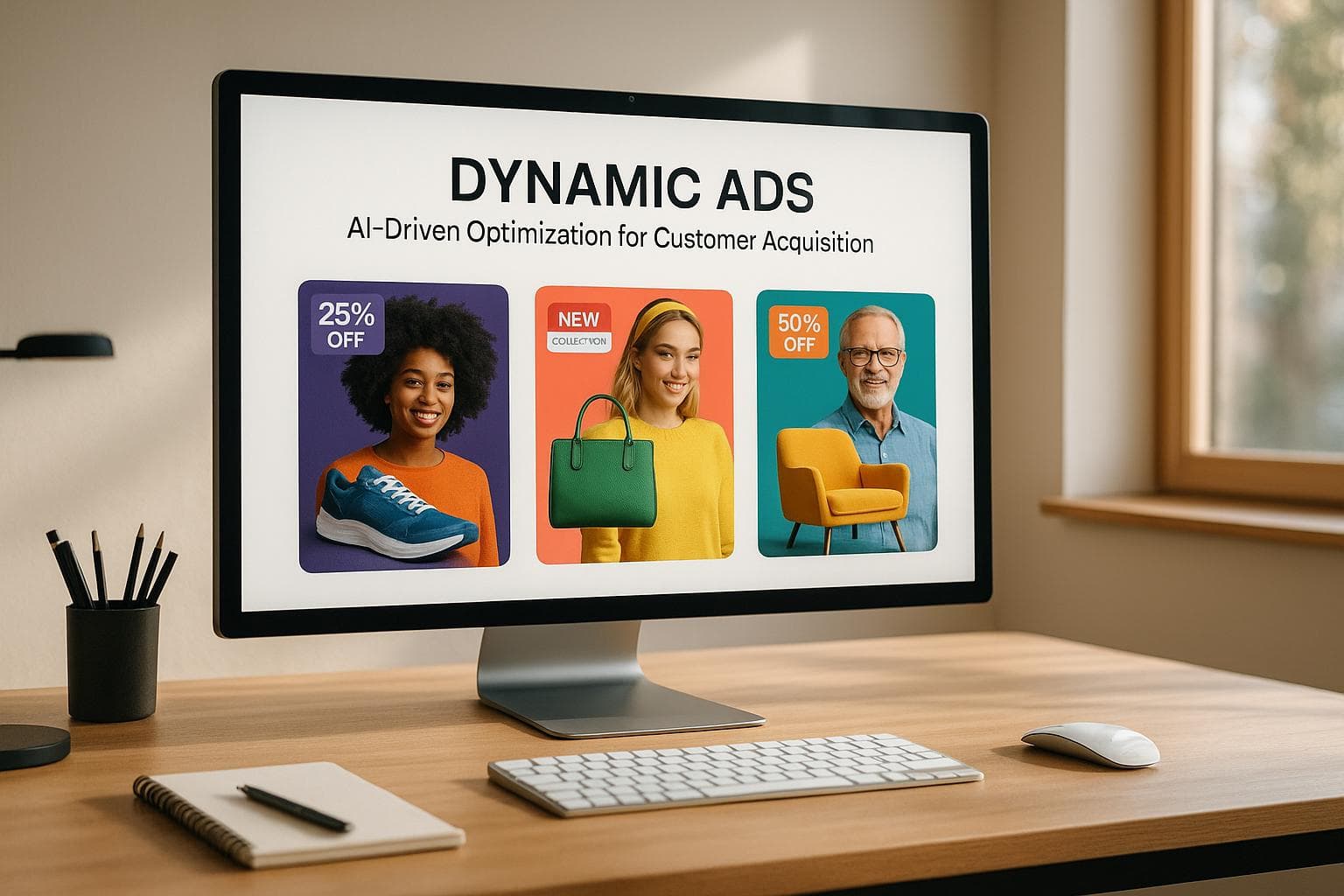AI Visual Content for E-commerce Ads
Explore how AI is revolutionizing e-commerce ads by enabling faster, cost-effective creation of personalized visual content.
AI is transforming e-commerce advertising by simplifying how businesses create visual content for their campaigns. Instead of relying on expensive photoshoots and long production timelines, brands can now use AI tools to generate high-quality product images, videos, and ads in minutes. Here’s why this matters:
- Faster Content Creation: AI tools can produce multiple ad variations instantly using just product data or URLs.
- Personalized Ads: AI analyzes user behavior to tailor visuals for different audience segments, boosting engagement and relevance.
- Scalable Campaigns: Easily manage and distribute visuals across platforms like Google, Meta, and Microsoft Ads while maintaining consistent branding.
- Cost and Time Savings: AI reduces production costs by up to 50% and speeds up workflows by cutting production time by 70%.
- Better Performance: AI-generated ads improve conversion rates by up to 14× and increase return on ad spend (ROAS) by 30%.
With over 6,300 brands already leveraging AI, tools like Feedcast.ai are making it easier for businesses to create, optimize, and scale their ad campaigns efficiently. Whether you’re a small business or managing thousands of products, AI-driven advertising is the key to staying competitive in today’s market.
how i turn product images into (animated) video ads using AI.
Benefits of AI-Generated Visual Content for E-Commerce Ads
AI-generated visual content is changing the game for e-commerce advertising. It’s not just about automating tasks - it’s about creating opportunities for better performance, more engaging customer experiences, and scalable growth across various marketing channels. From saving time and money to delivering personalized, impactful ads, AI is reshaping how brands connect with their audiences.
Time and Cost Savings Through Automation
Creating traditional visual content can be a logistical headache. Think about it: you need to hire photographers, book studio space, manage product shoots, and collaborate with graphic designers. All of this takes weeks and racks up costs. AI simplifies this process. For instance, AI avatars can generate user-generated content (UGC)-style videos that look authentic but cost a fraction of what traditional production would.
The time savings are impressive. Some AI editing tools have cut production times by as much as 70%, doubling output without increasing expenses[3]. On top of that, AI-generated visuals are now so realistic that they rival professional photography, eliminating the need for expensive stock image subscriptions or custom photo shoots[3]. This means marketing teams can shift their focus to strategy instead of getting bogged down in repetitive creative tasks.
Better Personalization for Higher Customer Engagement
Personalization is where AI truly shines. By analyzing user data and behavior, AI can create visuals tailored to specific audience segments. For example, it can recommend products and design ads that align with individual browsing histories or past purchases[1]. This could mean showing minimalist designs to a design enthusiast or featuring family-friendly settings for parents. The result? Ads that feel more relevant and engaging.
The numbers back this up. Some studies show that AI-generated ad creatives can boost sales by up to 14 times compared to traditional ads, with performance prediction accuracy exceeding 90%[4]. AI also allows for dynamic personalization throughout the customer journey. New visitors might see broad lifestyle imagery, while returning customers get detailed product features or time-sensitive offers, keeping the experience fresh and relevant.
Scalability for Multi-Channel Campaigns
AI doesn’t just make personalization easier - it also makes scaling campaigns across multiple channels a breeze. Platforms like Feedcast.ai let brands manage ad creatives in one place while automatically generating visuals for extensive product catalogs. This ensures consistent branding while meeting the unique needs of different platforms.
The impact is hard to ignore. Over 1 billion ad creatives have been generated by top brands using AI platforms, showing how scalable and efficient this technology has become[4]. Plus, AI-generated ads can boost return on ad spend (ROAS) by up to 30% through optimized A/B testing and creative variations[5]. For businesses, this translates into stronger performance and better results across the board.
How to Create and Optimize AI Visual Content for E-Commerce Ads
Creating AI-driven visual content for e-commerce ads might seem daunting, but it doesn’t have to be. With a clear plan, you can turn your product data into engaging ads that perform well across different platforms. Let’s break it down step by step.
Prepare Product Data and Assets
The quality of your product data sets the stage for successful AI-generated visuals. Start by gathering high-quality product photos. These should be clear, well-lit, and showcase your items from multiple angles. These images serve as the raw material for AI-powered ad creation.
Next, focus on your product descriptions. Make sure they’re accurate and detailed, including key information like SKUs, prices in U.S. dollars (e.g., $19.99), and current inventory levels. Organize this data in a structured format - spreadsheets or files like CSV, XML, or Google Sheets work well for importing into AI tools.
Don’t forget metadata. Including details like color, size, and category helps AI platforms create more targeted visuals. For instance, if you’re selling winter coats, adding attributes like "waterproof", "insulated", or "size XL" allows the AI to generate ads that highlight these features.
Stick to U.S. date formats and imperial units to align with local preferences. While this prep work may take some time, it significantly boosts the relevance and quality of your AI-generated content.
Choose an AI-Powered Ad Platform
Once your data is ready, the next step is selecting an AI platform to manage your campaigns. Look for tools that integrate seamlessly with multiple channels like Google, Meta (Facebook and Instagram), and Microsoft Ads. Features like AI-driven product feed management and automated ad creation are essential.
Platforms like Feedcast.ai are worth considering. They offer centralized ad management and AI-powered data enrichment. For example, Feedcast.ai can directly import products from Shopify, WooCommerce, or Prestashop and enhance product titles and descriptions to improve ad performance.
When evaluating platforms, prioritize those with analytics tailored to the U.S. market and compliance with American advertising standards. A unified dashboard simplifies campaign management, saving you time and reducing the complexity of multi-channel advertising.
Generate, Customize, and Refine Visuals
With your platform set up, it’s time to create and fine-tune your ad visuals. Start by generating initial designs, then customize them to align with your brand’s identity. Add your logo, use your brand’s colors and fonts, and ensure consistency across all creatives.
Localization is key when targeting U.S. audiences. Incorporate elements that resonate with local consumers, such as references to holidays like Thanksgiving or Black Friday. Use familiar settings and ensure measurement units (inches, pounds, Fahrenheit) match U.S. norms. These adjustments help your ads connect more effectively with American shoppers.
Create multiple variations of your visuals and use A/B testing to see which ones perform best. AI tools can quickly generate dozens of options, making it easier to experiment and find what resonates with your audience.
Lastly, ensure your visuals meet U.S. advertising regulations and accessibility standards. This includes clear disclosures and adherence to the specific policies of each ad platform.
Deploy and Monitor Ad Campaigns
Once your visuals are ready, deploying your campaigns should be straightforward, especially if you’re using a platform that supports multi-channel publishing. Tools like Feedcast.ai allow you to publish ads on Google, Facebook, Instagram, and Microsoft Ads all at once, streamlining the process.
After launching your campaigns, focus on tracking performance in real time. Monitor key metrics like click-through rates (CTR), conversion rates, cost per acquisition (CPA), return on ad spend (ROAS), and engagement rates. Display analytics using U.S. formats (e.g., 1,000.50) and local time zones for better insights.
Use a unified dashboard to view performance across all channels, making it easier to spot trends and optimize your campaigns. Regularly update your creatives based on performance data, rotate ads to keep them fresh, and adjust for seasonal trends or events that matter to U.S. audiences. AI analytics can help identify patterns and recommend improvements, making your optimization efforts more effective.
sbb-itb-0bd1697
Best Practices for Using AI in E-Commerce Visual Advertising
Get the most out of AI in visual advertising by aligning your designs with audience preferences, adhering to strict standards, and using data to refine your strategy continuously.
Tailor Visuals for U.S. Audience Segments
Understanding your American customers is key to creating visuals that drive conversions. AI tools can analyze demographic data, shopping habits, and customer preferences to craft visuals that truly connect with specific U.S. audience segments[4]. This isn't just about basic demographics - it's about tapping into regional behaviors, seasonal trends, and cultural nuances across the United States.
Break your audience into segments based on factors like age, location, and shopping behavior. For instance, if you're targeting millennials in urban areas, sleek, minimalist designs with mobile-friendly layouts might resonate. On the other hand, visuals for suburban families could emphasize practicality, value, and lifestyle benefits. AI platforms can adapt color palettes, imagery styles, and messaging to align with these preferences effortlessly.
Seasonal relevance is another important factor. Align your visuals with key U.S. shopping periods like back-to-school, Halloween, and Black Friday. AI-powered tools can integrate these seasonal elements with timely imagery and messages that feel relevant to your audience.
Regional preferences also matter. For example, visuals for Florida customers might highlight outdoor activities and sunny weather, while ads for Minnesota shoppers could focus on cozy indoor settings and cold-weather solutions. AI can analyze location data to adjust visuals, making them feel more personal and relevant across different states.
Finally, incorporating familiar American settings and cultural symbols into your visuals can make your ads resonate even more with local audiences.
Maintain Compliance and Brand Consistency
Once you've tailored your visuals to your audience, it's essential to ensure they comply with regulations and maintain brand consistency. AI tools can help automate compliance checks for U.S. advertising laws, such as FTC guidelines on truthfulness and transparency[1]. However, it's important to establish clear guidelines and conduct regular reviews to avoid any missteps.
Consistency across platforms is just as crucial. AI-driven design tools can help by applying pre-set templates, color schemes, fonts, and logos to all visuals, ensuring a cohesive look across campaigns[1]. Create a brand asset library that includes approved logos, color palettes, fonts, and style guidelines. Uploading these assets to your AI platform ensures every visual stays true to your brand identity.
U.S. advertising standards also require accessibility features like alt text, clear labeling, and honest claims[1]. Automating these elements - such as including disclaimers and disclosures - can streamline the process, but human oversight remains critical. Regular audits of AI-generated visuals are necessary to ensure they meet both regulatory standards and your brand's expectations.
For high-stakes campaigns or new product launches, human review is especially important. While AI can handle many tasks, a final review by your team ensures visuals align with your brand and comply with all necessary guidelines.
Use Analytics to Optimize Visuals
Once you've created tailored and compliant visuals, the next step is to use data to optimize their performance. AI analytics platforms can track real-time metrics like click-through rates, conversions, and engagement, breaking down performance by audience, channel, and creative type[4]. This level of detail helps identify which visual elements are working and which need improvement.
Some advanced AI tools can even predict which visuals are likely to perform best, allowing you to allocate resources more effectively and improve your conversion rates[4].
Keep an eye on key metrics such as CPA, ROAS, and conversion rates. Platforms like Feedcast.ai provide unified dashboards for cross-channel analysis, making it easier to make data-driven decisions that enhance your visuals and boost ROI.
To keep your visuals effective, set up automated rules to pause underperforming ads and shift budgets to those that are performing well. Use AI insights to uncover trends, like which color combinations resonate with specific age groups or which product angles drive more clicks at certain times.
Seasonal analysis can also be a game-changer. Look at how your visuals performed during major shopping periods like Black Friday, Cyber Monday, or back-to-school season. Use this historical data to shape your future campaigns.
Finally, regular testing and iteration are key. AI makes it easy to generate multiple visual variations, enabling you to test different approaches quickly. By systematically testing, measuring, and refining your visuals, you can stay ahead of audience preferences and ensure your content remains fresh and impactful.
Conclusion: E-Commerce Success with AI Visual Content
AI-powered visual content is reshaping the way e-commerce businesses approach advertising, making operations smoother, boosting engagement, and driving impressive sales growth. Companies leveraging AI-driven ad creative tools have reported sales increases of up to 14×, a 70% reduction in production time, and savings of 30–50% on creative costs [1][2][4].
These tools can produce high-quality visuals in just minutes, allowing businesses to test and optimize campaigns across multiple channels quickly. The result? Faster time-to-market, lower operational expenses, and a consistent brand identity across major advertising platforms.
One standout feature of AI in this space is its ability to personalize at scale. By analyzing customer data, shopping habits, and demographic trends, AI crafts ads that connect with specific audience segments. This kind of precision leads to higher click-through rates, better conversion rates, and ultimately, more sales.
Platforms like Feedcast.ai are leading the charge, offering the infrastructure businesses need to thrive in this AI-driven landscape. With over 3,000 e-commerce brands already on board, Feedcast.ai has proven its value by generating millions of clicks and sales. The platform integrates product data, ad creation, and performance analytics into a single, streamlined system, making it easier for businesses to manage their advertising efforts.
This approach levels the playing field, enabling smaller teams to compete with larger companies. Whether you're handling a single product line or managing thousands of SKUs, AI visual content tools empower businesses to run efficient, data-backed campaigns.
As e-commerce continues to evolve, adopting AI-driven strategies is no longer optional - it’s essential. Businesses that embrace these tools position themselves for long-term growth, achieving better results with fewer resources. For American e-commerce brands aiming to maximize their advertising ROI and scale efficiently, AI-powered visual content isn't just an advantage - it’s the way forward.
FAQs
How does AI help create personalized e-commerce ads, and how does this boost customer engagement?
AI takes e-commerce advertising to the next level by analyzing customer data to craft personalized ad content for various platforms. This means businesses can zero in on specific audiences, whether they're looking to attract new shoppers or reconnect with past customers.
By tailoring ads to individual preferences, AI makes it easier to grab attention, build loyalty, and boost the chances of turning views into purchases. The outcome? Stronger connections between brands and their customers, leading to better results for e-commerce businesses.
How can businesses prepare their product data for AI-generated visual content?
When it comes to creating AI-driven visual content, the foundation lies in well-prepared product data. Businesses should aim for data that’s complete, accurate, and structured. This means including detailed product titles, compelling descriptions, and high-quality images. Don't forget essential attributes like pricing, availability, and any other specifics that help define your product. Clean and organized data ensures that AI tools can generate visuals that not only look great but also connect with your audience.
Feedcast takes this a step further by using AI to refine and enhance product data. This process improves visibility and performance across advertising platforms. By automating these time-consuming tasks, businesses can focus on growing their e-commerce operations without getting bogged down in the details.
How can e-commerce businesses ensure their AI-generated visuals comply with U.S. advertising regulations?
To stay on the right side of U.S. advertising regulations when using AI-generated visuals, businesses need to stick to a few essential practices. First, any claims in advertisements must be truthful, not misleading, and backed by evidence. This is a requirement set by the Federal Trade Commission (FTC). For AI-generated visuals, this means avoiding exaggerated or false representations of products that could mislead consumers.
It's also important to clearly disclose any material relationships, like sponsorships or paid partnerships. Transparency is key when it comes to AI-generated content. If there's a chance that consumers might be misled, consider labeling or disclaiming the content as AI-created. Finally, make it a habit to review your advertising materials regularly and stay informed about the latest FTC guidelines. Doing so can help your business steer clear of compliance issues and potential fines.
Yohann B.










